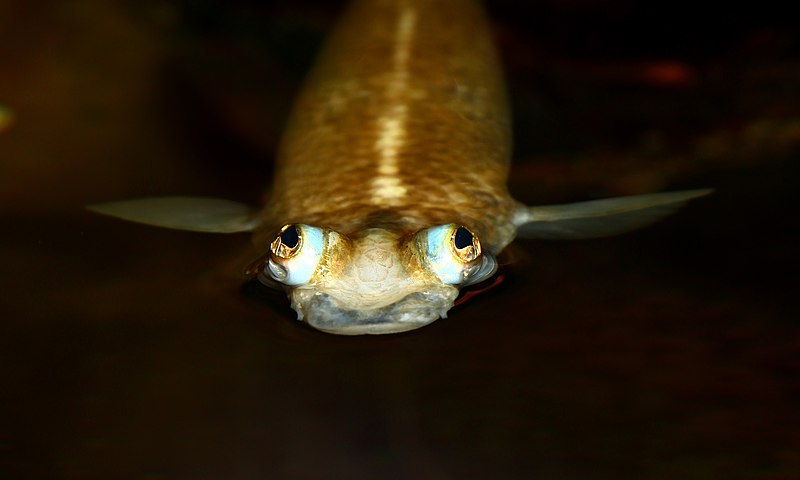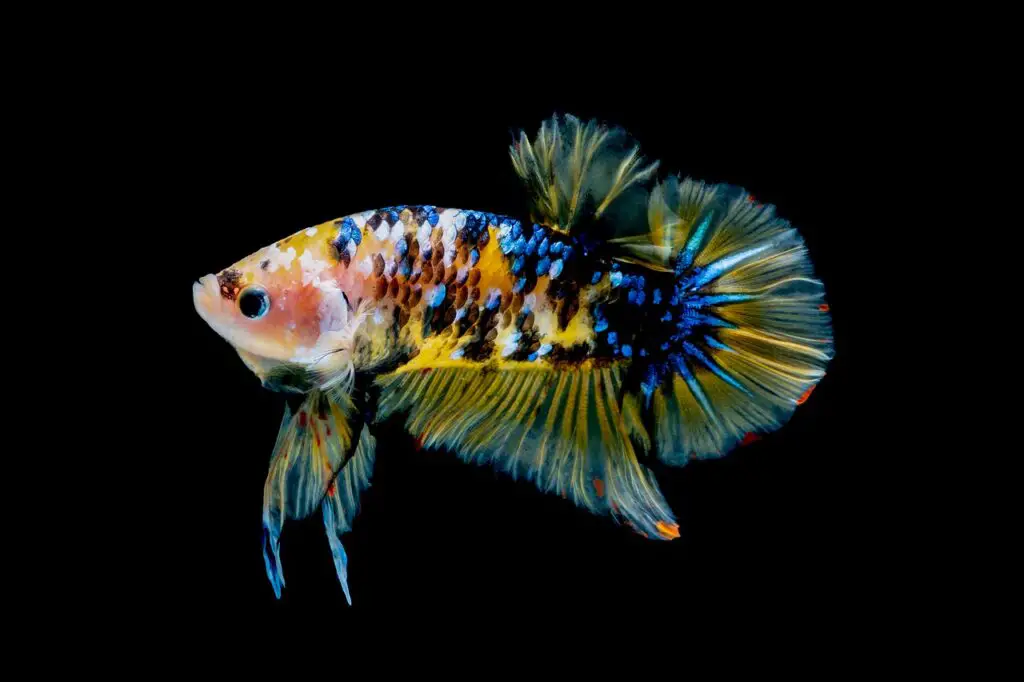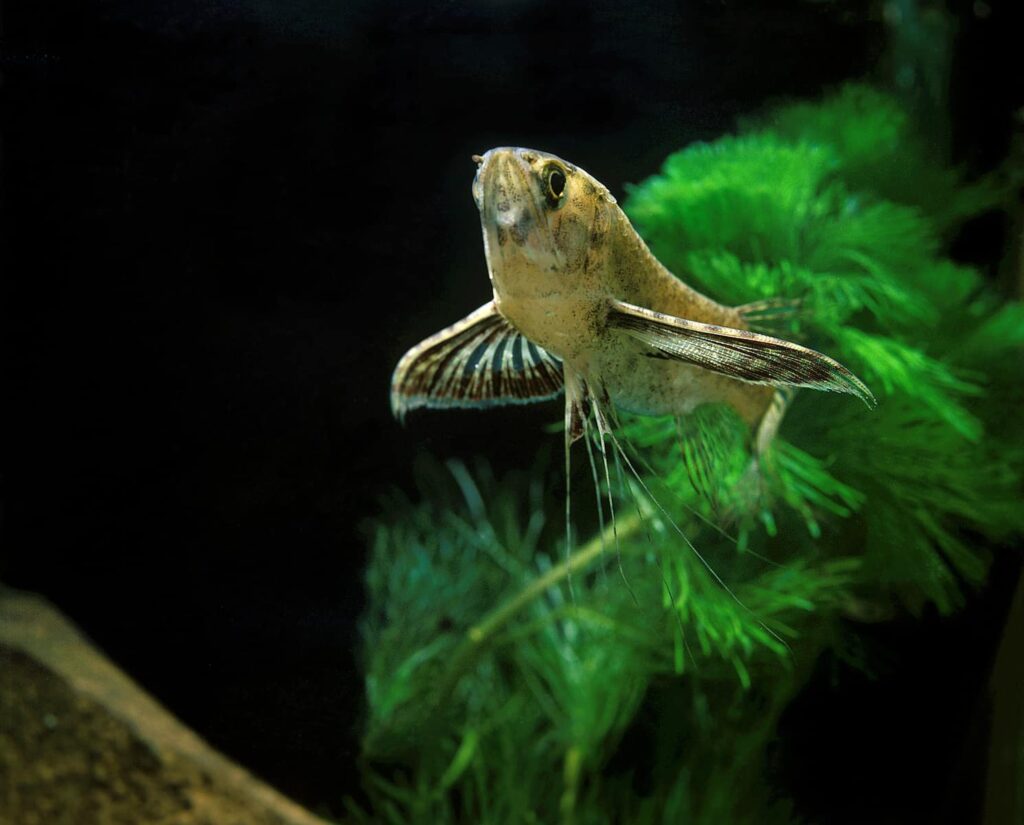This unusually named fish signifies its most interesting feature – that of appearing to have four eyes! In fact, this is a unique feature of this interesting fish. It does not actually have four eyes, but its two eyes are split into two parts, separated by narrow bands of tissue.
Each part has a pupil and can operate independently to focus on different directions! This fish can literally keep an eye on several things in focus, ideal for ‘crowd watch’, potential food supplies or threats, both above and below the water!
Their eyes are raised above the head and so swimming close to the surface gives the amazing ability for the fish to acquire information for decision-making and response. Here’s a bit more you might want to know about these curious critters.
- Fish Lifespan: Up to 8 Years
- Tank Size: 65 Gallons Ideal
- Water Temperature: Between 75F and 87F
- pH: Between 7.0 and 8.5
- Hardness: Between 10 and 25 dGH
- Compatibility: Compatible with Sail Fin Mollies and Archerfish
- Fish Size: Up to 8 Inches (Male) and Up to 12 Inches (Female)
How do you take care for Four Eyed Fish?
Just as Four Eyed Fish are physically interesting, they also have a few curious demands worth keeping an eye on (no pun intend). They love swimming up at the surface, which means you should ideally make sure to drop the water level in your tank to a sufficient amount for their needs. Generally, 12 inches is normally enough from the top. However, this fish is always likely to make a leap for it, so be prepared to close the lid on your Anableps as and when necessary.
You should ideally look into a gravel and rock bed for the Anableps. It’s likely there are plenty of other brackish fish out there, such as certain Mollies, which will cope well with these changes, too! What’s also important to keep in mind with the Four Eyed Fish is that they will love changes to their water regularly. However, you might want to only change out a fraction every couple of weeks.
As fish which thrive in schools, they are happiest with companions. 5 or 6 in a tank should ensure they are content, provided the tank is large enough and other types of fish they share the water with are not combative.
All in all, looking after a Four Eyed Fish or Anableps of your own can be a little bit of a challenge. They are not necessarily fish that we would recommend to beginners, however, there are much more difficult critters you could adopt and look after in your home tank. We think they make fantastic, interesting additions to any brackish environment, providing you make sure to research how to look after them properly!
Breeding Four Eyed Fish
Want to breed Anableps? It’s not impossible to do, but if you want more than a couple of these creatures in your tank, you must make sure you ‘tick a few boxes’ first.
These fish give birth to live young, but do not expect them to breed successfully unless the conditions are tranquil, and unless there is provision for adequate regular food supplies and shelter. The Anableps gestation period is eight weeks, and their offspring have the ‘Four Eyed Fish’ look straight away – fully functioning and ready to go!
You should take great care and remove young Anableps from your tank as soon as possible to avoid them being eaten by other fish. They can be given the same diet as adult Four Eyed Fish, though their food should grind up much smaller so pieces are small enough to swallow. You can gradually increase the size of the food as young fish grow.
You also need to take care in ‘sexing’ the youngsters so that, ideally, there is a careful ratio of male to female fish for future propagation. Who knew that breeding fish could be such a complex science?
What do Four Eyed Fish eat?
The Four Eyed Fish, or Anableps, tends to be a bit of a voracious meat-eater. Therefore, they tend to enjoy feeding on insects, including crickets. They also love eating mussels, crabs, small fish, shrimps, blood worms and snails. For this particular fish, a variety of different sources of food is a must.
What’s great about the Anableps is that it will thrive on a variety of different forms of meat and food in their tank. This means that you can feed them on live food and prey, as well as on freeze dried critters. Do make sure to ask your local aquarium expert for more advice on this.
Anableps don’t tend to be that picky, either. You can easily throw in a few pellets and flakes here and there, and they will happily snaffle them up.
Where do Four Eyed Fish come from?
You will normally find Four Eyed Fish or Anableps living around Central America and towards Trinidad and Tobago. However, they will also live slightly further south.
The Four Eyed Fish is a brackish creature, which means it’s likely to enjoy waters that are varyingly salty. This means you will need to keep a close eye on their tank conditions if you want to look after them properly, or if you want to breed them successfully.
Four Eyed Fish therefore like a pretty warm tank, and as an aquarium owner, it’s up to you to make sure you copy their wild conditions as best you possibly can!
Should I get a Four Eyed Fish?
The Four Eyed Fish is definitely a curious specimen and is always likely to be a prime pick for anyone looking for fish species that go a little beyond the ‘norm’. They are great fun to watch and will happily swim about in the right conditions.
However, this is a fish that we would not usually advise beginners look for – looking after an Anableps can require plenty of care and attention. This goes for most brackish fish, of course, but we’d generally advise you get this type of fish if you have at least some tank owning experience under your belt.



